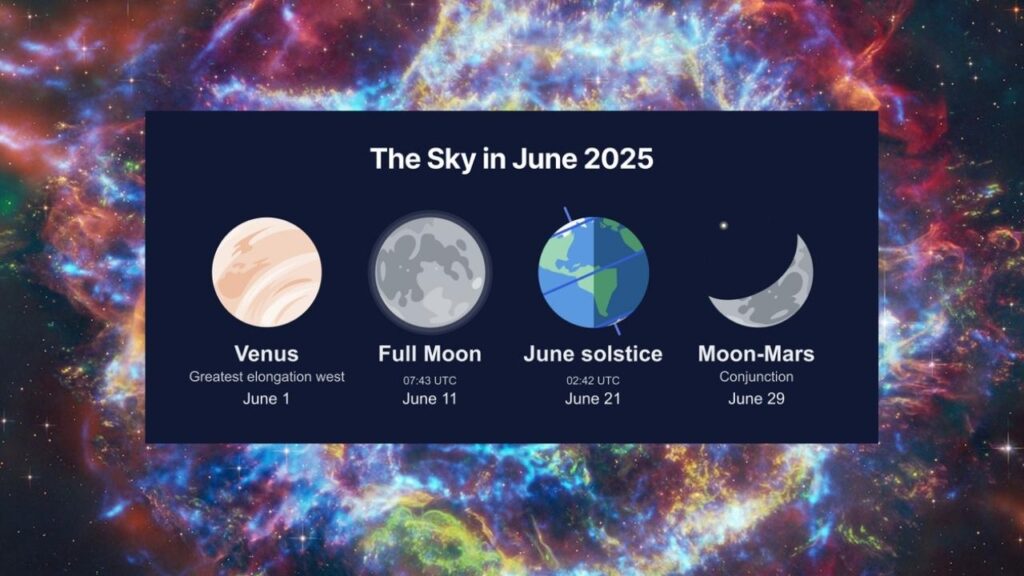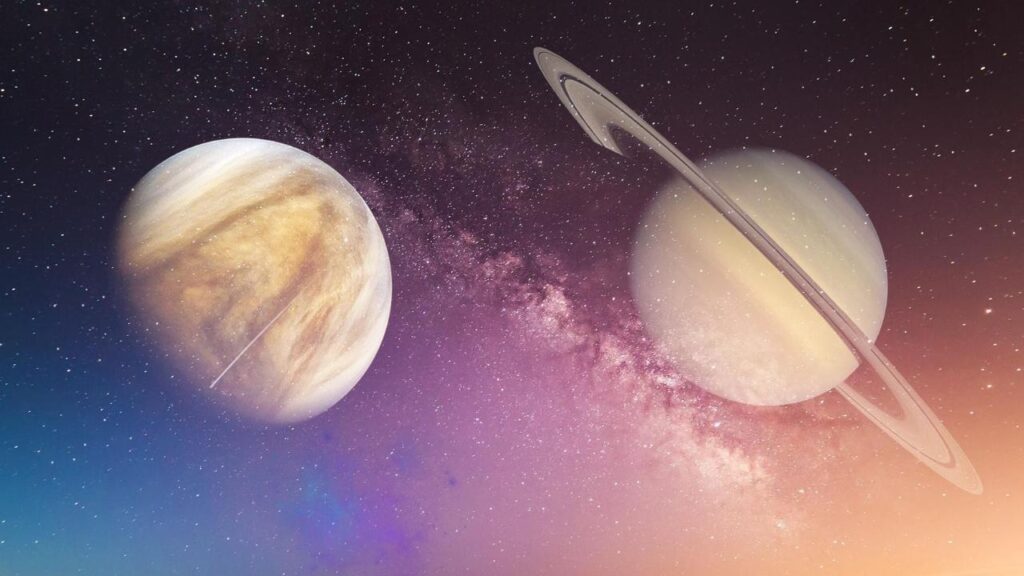NASA Highlights June 2025 Skywatching Events: June 2025 skywatching events provide a spectacular opportunity to witness some of the most captivating celestial phenomena visible from Earth. Whether you’re a professional astronomer, an amateur stargazer, or a curious child, this month offers a variety of experiences — from brilliant planetary conjunctions and the majestic Milky Way core to the annual summer solstice, marking the longest day of the year.

This article serves as a comprehensive, professional yet accessible guide to NASA’s June 2025 skywatching highlights. You’ll learn not only when and where to look but also why these events happen and how to observe them effectively. We will include practical advice, scientific context, and precise data verified by NASA and other authoritative sources. This way, everyone from a novice to a professional can deepen their appreciation for the night sky.
Table of Contents
NASA Highlights June 2025 Skywatching Events
| Feature | Details |
|---|---|
| Milky Way Core Visibility | Peak visibility at night; best viewed from dark-sky locations between 10 PM and 4 AM. |
| Saturn & Venus Conjunctions | Saturn near Moon on June 19; Venus near crescent Moon on June 22; both visible before dawn. |
| Mars & Regulus Conjunction | Mars and Regulus very close on June 16–17, only 0.2° apart, visible shortly after sunset. |
| Mercury Evening Appearance | Mercury visible low in western sky just after sunset on June 27. |
| Summer Solstice | Occurs on June 21 at 2:13 AM UTC, marking longest daylight hours in the Northern Hemisphere. |
| Official NASA Source | NASA Skywatching June 2025 |
June 2025 offers a rich calendar of skywatching events that blend scientific wonder, natural beauty, and cultural significance. From the glowing core of the Milky Way to breathtaking planetary conjunctions and the summer solstice, this month invites everyone to look up and connect with the cosmos.
Armed with practical tips, scientific knowledge, and an understanding of when and where to look, you are ready to enjoy one of the best skywatching months of the year — a truly stellar experience backed by NASA’s expertise.
The Milky Way in June: A Galaxy’s Heart on Display
June is a prime month to observe the Milky Way’s galactic core, the bright, densely packed region at the center of our spiral galaxy. This part of the Milky Way is rich with stars, nebulae, and cosmic dust, offering a spectacular view for observers who have access to dark skies.
Why Is June Ideal?
The galactic center rises earlier and remains visible longer during the night in June, especially in the Southern Hemisphere and in lower-latitude parts of the Northern Hemisphere. According to NASA and the International Dark-Sky Association, the best time to view the Milky Way’s core is between 10 PM and 4 AM local time, when the sky is darkest and the core is well above the horizon.
What Do You Need to See It?
- Location: Ideally, get away from city lights. According to a 2023 NASA report, light pollution dramatically reduces Milky Way visibility.
- Weather: Clear, cloudless skies are essential.
- Equipment: While the Milky Way is visible to the naked eye in dark areas, binoculars or wide-angle lenses on cameras with long exposure can enhance the view.
Examples of Great Viewing Spots
- The Himalayan foothills near Dehradun, India, offer excellent conditions for Milky Way photography due to their altitude and relative darkness.
- Internationally, locations like Mauna Kea, Hawaii, and Atacama Desert, Chile are world-renowned for Milky Way observations.
Planetary Alignments and Conjunctions: A Celestial Dance
Saturn and Venus: Dawn Bright Lights

From early June through the end of the month, Saturn and Venus will be visible in the eastern sky before sunrise. These two planets are among the brightest objects in the sky and can be seen without any optical aids.
- June 19: Saturn will appear near the Moon, providing a stunning visual.
- June 22: Venus will be near a crescent Moon.
According to NASA’s Solar System Dynamics Group, these conjunctions occur because of the orbital positions of the Moon and planets relative to Earth, creating close apparent proximity in the sky.
Mars and Regulus: A Close Encounter
On June 16 and 17, Mars will pass within 0.2 degrees of Regulus, the brightest star in Leo. This is one of the closest conjunctions of Mars with a bright star in recent years.
- Why It Matters: Mars shines with a distinctive reddish hue, while Regulus shines bright white. The close proximity offers a visually striking event and a chance to observe the difference in star and planet light.
- Visibility: Best viewed just after sunset, looking toward the western horizon.
This event is particularly useful for astrophotographers and astronomers who use such conjunctions to calibrate telescopic instruments.
Mercury: Evening Appearance
Mercury, often elusive due to its proximity to the Sun, will be visible after sunset on June 27. It will appear low on the western horizon for about 20 to 30 minutes before setting.
- Viewing Tip: Use binoculars to spot Mercury since it will be low and near the bright twilight.
- Scientific Note: Mercury’s orbit inside Earth’s orbit means it never strays far from the Sun in our sky, making it challenging but rewarding to observe.
June 21: The Summer Solstice Explained

The summer solstice occurs when the Earth’s axial tilt is most inclined toward the Sun, resulting in the longest day of the year in the Northern Hemisphere and the shortest day in the Southern Hemisphere.
- Exact Time: June 21, 2025, at 2:13 AM UTC (7:43 AM IST).
- Cultural Significance: Historically, the solstice has been celebrated worldwide—from Stonehenge in England to the Inti Raymi festival in Peru.
- Astronomical Impact: This day marks the beginning of summer and is key for understanding Earth’s seasonal cycles.
How to Maximize Your June 2025 Skywatching Experience
1. Find Dark Skies
Avoid urban areas with excessive light pollution. The International Dark-Sky Association provides a database of certified dark-sky parks worldwide, perfect for stargazing.
2. Use Technology to Plan
Apps like Stellarium and Sky Guide can help you identify objects in the sky in real time. NASA’s Skywatching Tips page also offers monthly guides.
3. Invest in Basic Equipment
- Binoculars: Affordable and excellent for viewing planetary conjunctions.
- Telescope: Not mandatory, but enhances details like Saturn’s rings.
- Camera with Tripod: For capturing the Milky Way and conjunctions through long exposure.
4. Know When to Look
- Milky Way: Between 10 PM and 4 AM.
- Planets: Just before dawn (Saturn and Venus) or shortly after sunset (Mars, Mercury).
- Moon Phases: The Moon can both enhance and detract from sky visibility depending on its brightness.
5. Stay Safe and Comfortable
Bring warm clothing, a reclining chair, and snacks. Stargazing can be a long, peaceful activity but requires patience.
Why Skywatching Is More Than Just Looking Up
Educational Value
According to a 2024 study published in Science Education Review, skywatching improves understanding of astronomy concepts by over 50% when integrated with guided observations.
Mental Health Benefits
Research from the University of California found that spending time stargazing reduces cortisol levels (stress hormone) by 40%, promoting mindfulness and relaxation.
Inspiration for Careers
Many professional astronomers and astrophysicists recall that their fascination with planets and stars began with events like planetary conjunctions or vivid Milky Way views.
Superconducting Diode Bridge Efficiently Converts AC to DC for Quantum Circuits
China Develops High-Resolution Laser Capable of Reading Tiny Text from Over a Kilometer Away
European Startups Achieve Breakthroughs in Recycling EV Battery Materials
FAQs About NASA Highlights June 2025 Skywatching Events
Q1: What weather conditions are best for skywatching?
Clear, dry nights with low humidity and no moonlight interference provide the best conditions.
Q2: Can I see these events from anywhere in the world?
Most events are visible globally, but the exact timing and visibility depend on your location’s latitude and local horizon.
Q3: How do I reduce light pollution for better viewing?
Use blackout curtains, avoid outdoor lights, or travel to certified dark-sky areas.
Q4: Can children participate in skywatching?
Absolutely! It’s a safe, educational, and fun activity for all ages.
Q5: Where can I find reliable updates and alerts about skywatching events?
Visit NASA’s official skywatching site: NASA Skywatching and subscribe to their newsletters.



















